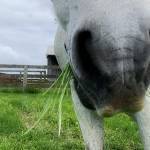Skip the Grass Clippings for Horses

Every home-owning horse owner has asked these questions during mowing season: why can’t I empty the mower bag into the paddock and let the horses relish the spoils of the season; why must I dump grass clippings into the compost pile or sneak them into the trash bin; what’s the difference between the grasses of my lawn and the grasses in the horses’ grazing areas? How bad can grass clippings be for horses, really?
While the idea seems innocuous enough, Catherine Whitehouse, M.S., a nutrition consultant with Kentucky Equine Research, provides a few compelling reasons to keep grass clippings and other yard waste out of your horse’s reach.
- “Many property owners treat their lawns and pastures as separate entities, and that’s a keen way to look at them as they serve different purposes,” Whitehouse said. “A property owner may, for instance, engage two companies to oversee care of her land: one that specializes in maintaining a yard plush enough for bare feet and bocce ball, and a second that optimizes growth of high-quality forage for animals.” While both companies may be expert and upstanding, they might not know the intricacies of the other. Chemicals used on the yard for fertilization or weed control, for example, could be inappropriate for consumption by horses. Chemicals applied to keep pastures in production, on the other hand, have been verified safe for consumption by horses. The same case can be made for forage types. Certain cultivars of common lawn grasses, such as fescue or ryegrass, may be susceptible to endophyte infection and thus problematic for horses. Different cultivars of the same forages could be endophyte-free and useful for grazing.
- As summer progresses, yard cleanup is in full swing, and grass clippings may be combined with other vegetation, dead or alive, tossed into a wheelbarrow, and thrown into a paddock. While shrub trimmings may seem harmless, many ornamental plants are toxic to horses, according to Whitehouse. A well-known example is yew (Taxus). Horses that have eaten as little as 1 lb (0.45 kg) of yew have died acutely, with clinical effects including nervousness, ataxia, diarrhea, and convulsions before death. Ornamental plants that can cause poisoning include foxglove, oleander, and lily of the valley, among many others. If debris from these plants is tossed in with the grass clippings, serious health problems could ensue.1 Problems tend to escalate, too, when horses bolt this yard waste because they have little else to eat.
- Cut grass decays in part through the fermentation of innate sugars by microorganisms. Fermentation releases heat, and this heat can be extreme, as high as 120-170○ F (49-77○ C). Grass clippings are, in fact, often used by experienced gardeners to increase the temperature within a compost pile to encourage decomposition. The center of a pile of clippings is moist and dark. Some of the microbes that thrive in this insulated environment, like Clostridium botulinum, are detrimental to horses, explained Whitehouse. Four horses died of botulism in northern California because they were fed grass clippings contaminated with Clostridium botulinum. The clippings were gathered from a nearby park and fed to horses that had limited access to other forage. As expected, the dominant horse in the herd was the most severely affected of the group and died first, and the lowest-ranking horse of the herd, and presumably the horse with the least access to the clippings, was the last to die.2
- For horses unaccustomed to grazing, grass clippings might represent an extreme departure from the normal diet. The fragility of the gastrointestinal tract is well known, and any sudden change can set off a health crisis, including colic and possibly founder.
The disadvantages of offering horses grass clippings far outweigh the benefits. By and large, it’s best to keep horses on a tried-and-true diet of appropriate pasture or hay with the addition of concentrated feeds to meet energy and nutrient needs.
1Knight, A.P. Poisonous plants. 2017. In: Waldridge, B.M. (editor) Nutritional management of equine diseases and special cases. John Wiley & Sons, pp. 119-188.
2Ostrowski, S.R., S.V. Kubiski, J. Palmero, C.M. Reilly, J.K. Higgins, S. Cook-Cronin, S.N. Tawde, B.M. Crossley, P. Yant, R. Cazarez, and F.A. Uzal. 2012. An outbreak of equine botulism type A associated with feeding grass clippings. Journal of Veterinary Diagnostic Investigation 24(3):601-603.








